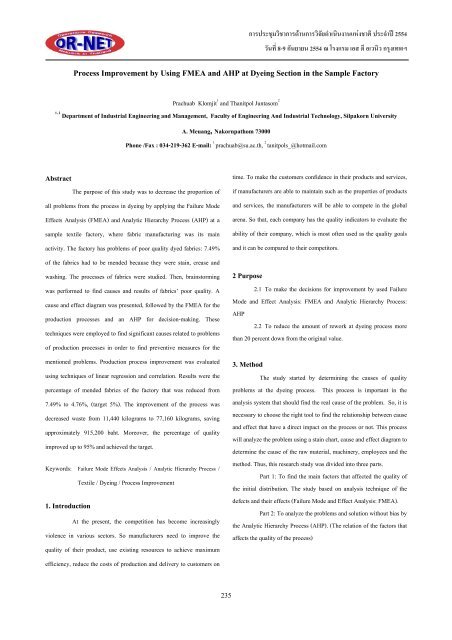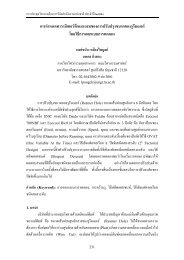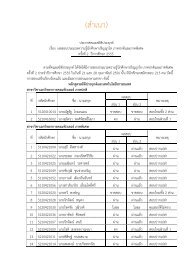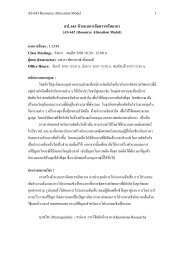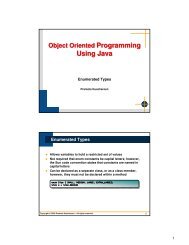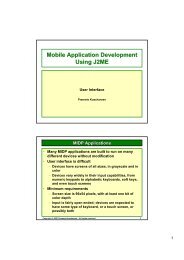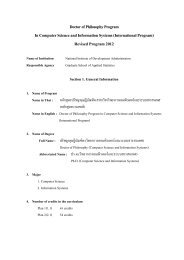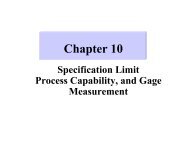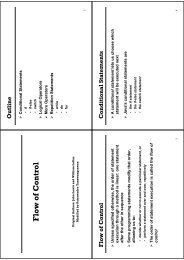ดาวน์โหลด All Proceeding - AS Nida
ดาวน์โหลด All Proceeding - AS Nida
ดาวน์โหลด All Proceeding - AS Nida
You also want an ePaper? Increase the reach of your titles
YUMPU automatically turns print PDFs into web optimized ePapers that Google loves.
235<br />
การประชุมวิชาการดานการวิจัยดําเนินงานแหงชาติ ประจําป 2554<br />
วันที่<br />
8-9 กันยายน 2554 ณ โรงแรม เอส ดี อเวนิว กรุงเทพฯ<br />
Process Improvement by Using FMEA and AHP at Dyeing Section in the Sample Factory<br />
Prachuab Klomjit 1 and Thanitpol Juntasom 2<br />
1, 2 Department of Industrial Engineering and Management, Faculty of Engineering And Industrial Technology, Silpakorn University<br />
A. Meuang, Nakornpathom 73000<br />
Phone /Fax : 034-219-362 E-mail: 1 prachuab@su.ac.th, 2 tanitpols_@hotmail.com<br />
Abstract<br />
The purpose of this study was to decrease the proportion of<br />
all problems from the process in dyeing by applying the Failure Mode<br />
Effects Analysis (FMEA) and Analytic Hierarchy Process (AHP) at a<br />
sample textile factory, where fabric manufacturing was its main<br />
activity. The factory has problems of poor quality dyed fabrics: 7.49%<br />
of the fabrics had to be mended because they were stain, crease and<br />
washing. The processes of fabrics were studied. Then, brainstorming<br />
was performed to find causes and results of fabrics’ poor quality. A<br />
cause and effect diagram was presented, followed by the FMEA for the<br />
production processes and an AHP for decision-making. These<br />
techniques were employed to find significant causes related to problems<br />
of production processes in order to find preventive measures for the<br />
mentioned problems. Production process improvement was evaluated<br />
using techniques of linear regression and correlation. Results were the<br />
percentage of mended fabrics of the factory that was reduced from<br />
7.49% to 4.76%, (target 5%). The improvement of the process was<br />
decreased waste from 11,440 kilograms to 77,160 kilograms, saving<br />
approximately 915,200 baht. Moreover, the percentage of quality<br />
improved up to 95% and achieved the target.<br />
Keywords: Failure Mode Effects Analysis / Analytic Hierarchy Process /<br />
Textile / Dyeing / Process Improvement<br />
1. Introduction<br />
At the present, the competition has become increasingly<br />
violence in various sectors. So manufacturers need to improve the<br />
quality of their product, use existing resources to achieve maximum<br />
efficiency, reduce the costs of production and delivery to customers on<br />
time. To make the customers confidence in their products and services,<br />
if manufacturers are able to maintain such as the properties of products<br />
and services, the manufacturers will be able to compete in the global<br />
arena. So that, each company has the quality indicators to evaluate the<br />
ability of their company, which is most often used as the quality goals<br />
and it can be compared to their competitors.<br />
2 Purpose<br />
2.1 To make the decisions for improvement by used Failure<br />
Mode and Effect Analysis: FMEA and Analytic Hierarchy Process:<br />
AHP<br />
2.2 To reduce the amount of rework at dyeing process more<br />
than 20 percent down from the original value.<br />
3. Method<br />
The study started by determining the causes of quality<br />
problems at the dyeing process. This process is important in the<br />
analysis system that should find the real cause of the problem. So, it is<br />
necessary to choose the right tool to find the relationship between cause<br />
and effect that have a direct impact on the process or not. This process<br />
will analyze the problem using a stain chart, cause and effect diagram to<br />
determine the cause of the raw material, machinery, employees and the<br />
method. Thus, this research study was divided into three parts.<br />
Part 1: To find the main factors that affected the quality of<br />
the initial distribution. The study based on analysis technique of the<br />
defects and their effects (Failure Mode and Effect Analysis: FMEA).<br />
Part 2: To analyze the problems and solution without bias by<br />
the Analytic Hierarchy Process (AHP). (The relation of the factors that<br />
affects the quality of the process)


